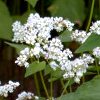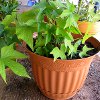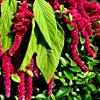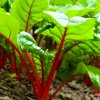
There are a million gardening books out there to tell you how to grow perfect tomatoes and lettuces. And that's important — in my house, salsa is a food group. For those of us attempting to grow a large portion of our calories ourselves, however, tomatoes and lettuce are not sufficient — we need to either get the most calories or the best possible nutrition out of our kitchen gardens and landscaping. So I've compiled a list of plants, both annual and perennial, that I think are an important addition to many home gardens.
 Buckwheat. Buckwheat is the perfect multipurpose plant. Many of you have probably used it as a green manure, taking advantage of its remarkable capacity to shade out weeds and produce lots of green material to enrich the soil. But it is also one of the easiest grains to grow in the garden — simply let it mature and harvest the seed, and the leaves make a delicious and highly nutritious salad or cooking green. Although it won't be quite as good at soil building if you do it this way, buckwheat can be used as a triple-purpose crop — plant a few beds with it, harvest the greens steadily (but lightly) for salad (it is particularly good during the heat of summer since it has a lightly nutty taste not too far off lettuce and will grow in hot weather), cook some of the mature greens, harvest the seeds, then cut the plants back to about an inch, leaving the plant material on the ground. The buckwheat will then grow back up again and you can harvest young salad greens and cut it back again for green manure.
Buckwheat. Buckwheat is the perfect multipurpose plant. Many of you have probably used it as a green manure, taking advantage of its remarkable capacity to shade out weeds and produce lots of green material to enrich the soil. But it is also one of the easiest grains to grow in the garden — simply let it mature and harvest the seed, and the leaves make a delicious and highly nutritious salad or cooking green. Although it won't be quite as good at soil building if you do it this way, buckwheat can be used as a triple-purpose crop — plant a few beds with it, harvest the greens steadily (but lightly) for salad (it is particularly good during the heat of summer since it has a lightly nutty taste not too far off lettuce and will grow in hot weather), cook some of the mature greens, harvest the seeds, then cut the plants back to about an inch, leaving the plant material on the ground. The buckwheat will then grow back up again and you can harvest young salad greens and cut it back again for green manure.
 Sweet potatoes. Think this is a southern crop? Not for me. I grow "Porto Rico" sweet potatoes in upstate New York. Garden writer Laura Simon grows them in cool, windy Nantucket. I've met people who grow them in Ontario and North Dakota. Sweet potatoes have quite a range if started indoors, and more northerners should grow them. They are enormously nutritious, unutterably delicious and store extremely well (some of my sweets last more than a year). They do need light, sandy soil and good drainage, so I grow them mostly in raised beds with heavily amended soil — my own heavy wet clay won't do.
Sweet potatoes. Think this is a southern crop? Not for me. I grow "Porto Rico" sweet potatoes in upstate New York. Garden writer Laura Simon grows them in cool, windy Nantucket. I've met people who grow them in Ontario and North Dakota. Sweet potatoes have quite a range if started indoors, and more northerners should grow them. They are enormously nutritious, unutterably delicious and store extremely well (some of my sweets last more than a year). They do need light, sandy soil and good drainage, so I grow them mostly in raised beds with heavily amended soil — my own heavy wet clay won't do.
 Blueberries. If there was ever an ornamental edible, this is it. A prettier shrub than privet or most common privacy hedge plants, it produces berries and turns as flaming red as any burning bush in the autumn. I have no idea why more people don't landscape with blueberries. Add to that the fact that they have more antioxidants than most other foods and, unlike other good-for-you crops, will be eaten by the bucketful by kids. They do need acidic soil, but there are blueberries for all climates. They are definitely worth replacing your shrubs with if you can.
Blueberries. If there was ever an ornamental edible, this is it. A prettier shrub than privet or most common privacy hedge plants, it produces berries and turns as flaming red as any burning bush in the autumn. I have no idea why more people don't landscape with blueberries. Add to that the fact that they have more antioxidants than most other foods and, unlike other good-for-you crops, will be eaten by the bucketful by kids. They do need acidic soil, but there are blueberries for all climates. They are definitely worth replacing your shrubs with if you can.
 Amaranth. I've grown amaranth before, but my first year growing "Golden Giant" and "Orange" was fascinating. In two five-by-four-feet beds, I harvested 11.2 and 13.9 pounds of amaranth seed respectively. The plants are stunningly beautiful — nine feet tall, bright honey gold or deep orange, with green variegated leaves. The leaves are also a good vegetable cooked with garlic and sauteed or done Southern style. Amaranth is an easy grain crop to harvest and use, is delicious, can be popped like popcorn and makes wonderful cereal. Despite its adaptation to the Southwest (where it routinely yields extremely well with minimal water), it tolerated my wet, humid climate just fine. My chickens love it too.
Amaranth. I've grown amaranth before, but my first year growing "Golden Giant" and "Orange" was fascinating. In two five-by-four-feet beds, I harvested 11.2 and 13.9 pounds of amaranth seed respectively. The plants are stunningly beautiful — nine feet tall, bright honey gold or deep orange, with green variegated leaves. The leaves are also a good vegetable cooked with garlic and sauteed or done Southern style. Amaranth is an easy grain crop to harvest and use, is delicious, can be popped like popcorn and makes wonderful cereal. Despite its adaptation to the Southwest (where it routinely yields extremely well with minimal water), it tolerated my wet, humid climate just fine. My chickens love it too.
 Chickpeas. Unlike most beans, which must be planted after the last frost, chickpeas are highly nutritious and extremely frost tolerant. Plant breeder Carol Deppe has had them overwinter in the Pacific Northwest, and they can be planted as early as April or as late as July here and still mature a crop. Unlike peas and favas that don't like hot weather, and most dry beans that don't like cold, chickpeas seem happy no matter what. If you've only ever eaten store chickpeas, you'll be fascinated to experience homegrown ones — they are, in many ways, as big a revelation as homegrown tomatoes.
Chickpeas. Unlike most beans, which must be planted after the last frost, chickpeas are highly nutritious and extremely frost tolerant. Plant breeder Carol Deppe has had them overwinter in the Pacific Northwest, and they can be planted as early as April or as late as July here and still mature a crop. Unlike peas and favas that don't like hot weather, and most dry beans that don't like cold, chickpeas seem happy no matter what. If you've only ever eaten store chickpeas, you'll be fascinated to experience homegrown ones — they are, in many ways, as big a revelation as homegrown tomatoes.
 Beets. I know, I know, there' s no vegetable anyone hates as much as the beet. Poor beets — they are so maligned. We should all be eating more beets — especially pregnant women, women in their childbearing years who may become pregnant, and those at risk of heart disease or stomach or colon cancer. Beets are rich in folate and good for you in a host of other ways. They store well, yield heavily, provide highly nutritious greens for salad and cooking and are the sweetest food in nature. If you hate beets, give them another try consider roasting them with salt and pepper or steaming them and pureeing them with apples and ginger. Laurie Colwin used to swear her recipe for beets with angel hair pasta could turn anyone into a beet lover, while a recipe for beets with tahini has converted many of my friends. Really, try them again!
Beets. I know, I know, there' s no vegetable anyone hates as much as the beet. Poor beets — they are so maligned. We should all be eating more beets — especially pregnant women, women in their childbearing years who may become pregnant, and those at risk of heart disease or stomach or colon cancer. Beets are rich in folate and good for you in a host of other ways. They store well, yield heavily, provide highly nutritious greens for salad and cooking and are the sweetest food in nature. If you hate beets, give them another try consider roasting them with salt and pepper or steaming them and pureeing them with apples and ginger. Laurie Colwin used to swear her recipe for beets with angel hair pasta could turn anyone into a beet lover, while a recipe for beets with tahini has converted many of my friends. Really, try them again!
 Flax. You can grow this one in your flower beds, mixed in with your marigolds. Flax is usually a glorious blue — the kind of blue all flower gardeners covet. But the real reason to grow it is the seeds. Flaxseed oils are almost half omega-3 fatty acids. A recent article claimed that we have no choice but to turn to GMO crops to provide essential omega-3s without stripping the ocean — ignoring the fact that we can and should be growing flax everywhere, and enjoying flaxseed in our baked goods and our meals. Flax is particularly valuable in northern intensive gardening, which tends to be low in fats. If you grow more than you need, flaxseed is also excellent chicken feed — my poultry adore it.
Flax. You can grow this one in your flower beds, mixed in with your marigolds. Flax is usually a glorious blue — the kind of blue all flower gardeners covet. But the real reason to grow it is the seeds. Flaxseed oils are almost half omega-3 fatty acids. A recent article claimed that we have no choice but to turn to GMO crops to provide essential omega-3s without stripping the ocean — ignoring the fact that we can and should be growing flax everywhere, and enjoying flaxseed in our baked goods and our meals. Flax is particularly valuable in northern intensive gardening, which tends to be low in fats. If you grow more than you need, flaxseed is also excellent chicken feed — my poultry adore it.
©2012 by Sharon Astyk. All rights reserved.
Reprinted with permission of the publisher,
New Society Publishers. www.newsociety.com
(Editor's Note: Other plants covered in this same section of the book are: Popcorn. Kidney beans. Rhubarb. Turnips. Maximillian sunflowers. Hopi orange winter squash. Annual alfalfa. Potatoes. Sumac. Parsnips. Potato onions. King Stropharia mushrooms (aka winecaps). Filberts/hazelnuts. Elderberries. Annual sunflowers. Rice. Jerusalem artichokes. Kale/collards. )
This article was reprinted with permission from Chapter 8 of the book:
Making Home: Adapting Our Homes and Our Lives to Settle in Place
by Sharon Astyk.
 Making Home is about improving life with the people around us and the resources we already have. While encouraging us to be more resilient in the face of hard times, author Sharon Astyk also points out the beauty, grace, and elegance that result. Written from the perspective of a family who has already made this transition, Making Home shows readers how to turn the challenge of living with less into settling for more — more happiness, more security, and more peace of mind.
Making Home is about improving life with the people around us and the resources we already have. While encouraging us to be more resilient in the face of hard times, author Sharon Astyk also points out the beauty, grace, and elegance that result. Written from the perspective of a family who has already made this transition, Making Home shows readers how to turn the challenge of living with less into settling for more — more happiness, more security, and more peace of mind.
Click here for more info and/or to order this book.
About the Author
 Sharon Astyk is a writer, teacher, blogger, and farmer who raises vegetables, poultry and dairy goats with her family in upstate New York. She and her family use 80% less energy and resources than the average American household. Sharon is a member of the Board of Directors of ASPO-USA (Association for the Study of Peak Oil and Gas USA), founder of the Riot 4 Austerity, and the award-winning author of four previous books including Making Home, Depletion and Abundance and Independence Days.
Sharon Astyk is a writer, teacher, blogger, and farmer who raises vegetables, poultry and dairy goats with her family in upstate New York. She and her family use 80% less energy and resources than the average American household. Sharon is a member of the Board of Directors of ASPO-USA (Association for the Study of Peak Oil and Gas USA), founder of the Riot 4 Austerity, and the award-winning author of four previous books including Making Home, Depletion and Abundance and Independence Days.

























